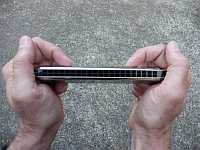First Sounds - Tremolo Lesson 1
You have a new tremolo harmonica, or perhaps an older one now ready for use. These lessons unlock the music from this wonderful instrument. Start the player below to hear how it sounds.
This tune is "Lord Inchquin", later you will learn it.
These lessons are for the Asian tremolo harmonica, the most widely used instrument of the harmonica family. There are several tremolo types. Look at the top of your instrument and count the holes - 24, perhaps 21, maybe even 22. Either way, your tremolo will fit these lessons.
Your instrument should also have a "C" on it somewhere. This means the instrument is in the key of C (music keys are explained later). Most likely your harmonica is in C. If not then find one that is, so you can match the music tracks in the lessons.
Now hold the instrument with one hand at each end. Rest the harmonica on the second finger of each hand, with the first finger laying on the top cover. Place your thumb on each edge, like the photo.

Now place your mouth over the instrument, covering the first four holes on the left hand side. Blow gently. It should sound like this.
If the sound is much higher, or there is no sound, then the instrument is upside down. Turn it around and try again. Keep your thumbs on the edge of the instrument, away from your lips.
Now cover the same holes with your mouth, this time breathe in. It sounds like this.
Notice also how the sound wavers. Each note is made by a pair of reeds, tuned slightly apart. The wavering comes from each reed pair sounding together, the tremolo sound gives the instrument its name.
Now make the same sounds, this time with a backing track. Blow four times, then breathe in (or draw) four times, then blow once more to finish.
Finally, try by yourself, with the accompaniment only.
Play these tracks over and over (do this by pulling back the slider). Try with a stronger breath, then a lighter breath. Search for the best sound.
The first lesson ends, your music journey begins. Take the following lessons slowly, practise each exercise many times. You'll soon be playing.
Click here for the next lesson.